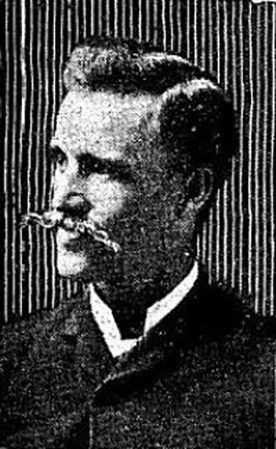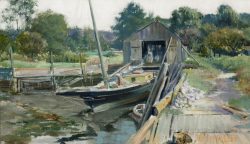Charles Abel Corwin, from a photograph reproduced in Chicago Tribune, Nov. 1, 1900.

Charles Corwin 1857–1938
Landscape and mural painter Charles Abel Corwin was born at Newburgh-on-Hudson, New York, the son of a clergyman whose postings took the family to Honolulu, Hawaii, and to Oakland, California. Corwin received his initial artistic training at the Cooper Union in New York, followed by two years of study at the Royal Academy in Munich. He was one of the famed “Duveneck Boys,” a group of young artists who followed the influential Cincinnati-born painter Frank Duveneck on sketching expeditions in the Bavarian countryside and to Venice and Florence between 1879 and 1881. Back in the U.S., Corwin’s extensive work as a painter of cycloramas—large in-the-round paintings popular before the advent of the motion picture—brought him to Chicago in the early 1880s and prepared him for his successful later career as a painter of murals and dioramas.
Corwin began teaching at the Art Institute of Chicago in 1883 but he did not settle in the Chicago area until 1891. In the 1890s, in addition to undertaking large-scale painting projects, he emerged as one of Chicago’s rising painters of landscapes in oils and watercolors. He exhibited in the Art Institute’s various annual exhibitions, beginning in 1894. Corwin painted in Indiana, along the Michigan shore, and on the New England coast, particularly in picturesque Gloucester, Massachusetts, long a haunt of landscape artists. The brother of architect Cecil Corwin, a close friend of Frank Lloyd Wright, Corwin made architectural renderings for Wright and painted a mural in the playroom of Wright’s home in suburban Oak Park, where the artist also lived. At the turn of the century, Corwin further demonstrated the diversity of his artistic talents when he designed a stained-glass window in a South Side church and won the Art Institute’s Martin B. Cahn Prize for his Gloucester landscape painting Ten Pound Island (formerly Friedman Collection).
After 1900, Corwin showed his easel paintings in the annual salons of the Pennsylvania Academy of the Fine Arts in Philadelphia and the Boston Art Club. He painted portraits as well as landscapes and figural works, many of Western and American Indian subjects. Increasingly, however, Corwin devoted himself to monumental painting. In 1903, he began a long association with Chicago’s Field Museum of Natural History, painting some eighty backgrounds for habitat displays as well as a series of large murals on the theme of exotic plants. He undertook similar work for the California Academy of Sciences in San Francisco and for the University of Iowa. By the time he died at age eighty-one, Corwin was remembered not as a talented landscape artist but as one of the nation’s foremost creators of illusionistic backgrounds for museum displays.
Wendy Greenhouse, PhD
